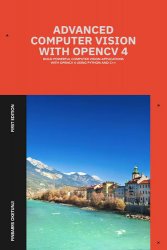Advanced Computer Vision with OpenCV 4
- Добавил: literator
- Дата: 4-05-2025, 15:45
- Комментариев: 0
 Название: Advanced Computer Vision with OpenCV 4: Build powerful computer vision applications with OpenCV 4 using Python and C++
Название: Advanced Computer Vision with OpenCV 4: Build powerful computer vision applications with OpenCV 4 using Python and C++Автор: Finbarrs Oketunji
Издательство: Independently published
Год: November 22, 2024
Страниц: 827
Язык: английский
Формат: pdf, epub, mobi
Размер: 10.1 MB
Advanced Computer Vision with OpenCV 4 presents techniques and methods for developing computer vision applications using OpenCV 4. The book enables software engineers, researchers, and computer vision enthusiasts to implement advanced image and video processing systems.
OpenCV (Open Source Computer Vision Library) stands as one of the most powerful and widely-used open-source libraries for computer vision and image processing. Since its initial release in 2000, OpenCV has evolved significantly, with version 4 introducing substantial improvements in performance, functionality, and deep learning capabilities.
In the Chapter 1, we’ll establish a solid foundation for working with OpenCV 4. We’ll begin by understanding the library’s architecture, followed by setting up a proper development environment for both Python and C++. You’ll learn about the core concepts, basic image operations, and important data structures that form the backbone of OpenCV applications.
Key topics we’ll cover:
• Understanding OpenCV’s architecture and modules
• Setting up development environments for Python and C++
• Working with basic image I/O operations
• Managing different image formats and colour spaces
• Exploring fundamental data structures in OpenCV
• Best practices for memory management and optimisation
In the realm of computer vision, understanding how images and videos are represented and manipulated at a fundamental level is crucial for developing robust applications. The Chapter 2 looks into the essential concepts that form the backbone of image and video processing with OpenCV 4. We’ll explore how digital images are structured as multi-dimensional arrays of pixels, each carrying intensity or colour information. You’ll learn about different colour spaces (RGB, HSV, LAB), their practical applications, and when to use each one. We’ll also examine various image formats (JPEG, PNG, TIFF) and their implications for computer vision tasks. The Chapter 2 then transitions into video fundamentals, explaining how sequences of images create motion, frame rates, video codecs, and the importance of temporal information in video analysis. We’ll cover practical aspects of video capture, streaming, and storage, alongside essential techniques for efficient video processing.
The book includes:
Complete setup guides for OpenCV 4 development environments
Detailed implementations of image processing and filtering techniques
Advanced feature detection and matching algorithms
Practical object detection and tracking systems
Complete face analysis and recognition implementations
Real-time motion tracking and analysis solutions
Camera calibration and 3D vision techniques
Integration patterns with machine-learning frameworks
Performance optimization strategies for CPU and GPU
Development tools and best practices for OpenCV projects
Project structure and maintenance guidelines
Скачать Advanced Computer Vision with OpenCV 4
Внимание
Уважаемый посетитель, Вы зашли на сайт как незарегистрированный пользователь.
Мы рекомендуем Вам зарегистрироваться либо войти на сайт под своим именем.
Уважаемый посетитель, Вы зашли на сайт как незарегистрированный пользователь.
Мы рекомендуем Вам зарегистрироваться либо войти на сайт под своим именем.
Информация
Посетители, находящиеся в группе Гости, не могут оставлять комментарии к данной публикации.
Посетители, находящиеся в группе Гости, не могут оставлять комментарии к данной публикации.
